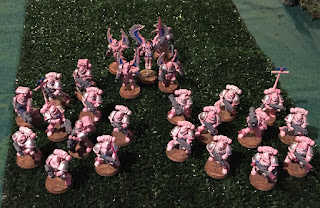Balance is one of
the most challenging aspects of wargame design. It is frequently an
area of contention between players and causes friction within the
gaming communities. I personally think this topic and HistoricalScenarios are the most difficult aspect of wargame design to get
right. Therefore, let's take a closer look at the process.
Perfect Balance
Many gamers will
bang on about the idea of “Perfect Balance”. The idea is that
any unit of a given points cost can perform just as well as any other
selection of the same points. Quality can off-set quantity, damage
output can be off set by damage resistance, speed can be off set by
control, etc. Essentially, perfect balance would be that two players
could choose any options they want and their abilities would off set
enough that the game would still be completely fair and even. Only
the skill of the two players would impact the outcome.
Many beginning
game designers think balance, army lists, and points is simple
algorithm or code. Once you crack the code and create the perfect
formula then all units will be balanced. They spend a lot of time
considering points scales, skill levels, damage output, special
abilities, and hundreds of other factors. They make elaborate spread
sheets and calculate various variables. They spend hours mix and
matching and testing these variables against each other.
Unicorns and ROY G. BIV
To quote the
famous philosophers They Might Be Giants, “You'll
never see a unicorn, but you can see a rainbow. Inside every Rainbow
is ROY G. BIV!”
Perfect balance is the unicorn. It does not exist. No matter the
system you put in place.... someone, somewhere will break it.
Someone will tell you how wrong you are. Someone will tell you all
the flaws in your logic. A wargame has too many variables a game
designer simply can not control to build and implement them into any
magic formula. Some examples of uncontrollable variables include:
- Variability of Terrain- No one has uniform sizes and types of terrain. I may have lot's of hills, while someone else uses all ruins.
- Model Availability- Players have all sorts of different models to play with. As the designer you can not control that.
- Player Skill- Some people are just better at calculating risk and odds on the fly than others. Some can judge distances really well.
- RNG- The Random Number Generators designers build for can be imperfect tools.
The list can go on
and on. These can not be planned for in any formula. Some games can
control these variables better than a free form tabletop wargame.
For example, board games can set the “terrain” and provide a set
group of models. Card Games can control the RNGs much better. The
fewer variables, the closer you can get to “Perfect Balance”
however no game controls all the variables. It is impossible.
On
the other hand, there are tools a game designer can use to simplify
balance. These are the ROY G. BIV. In the song, you can see ROY G
BIV inside every rainbow as ROY G BIV is just an acronym for the
color spectrum. IE, the tools game designers use the ROY G BIV of
balance is Points, Army Lists, and Scenarios.
Points
In the olden days
of wargaming yore, there was no such thing as points. Wargames were
firmly based on actual historical encounters. You see wargaming was
originally serious business. Military and General Staff Colleges
used wargaming as a way to test doctrine, theory, and teach officers.
Therefore, armies and forces were not balanced in anyway.
Instead, players were expected to research what forces were actually
at the battles and provide them some sort of stats to match their
performance on the field.
Eventually, some
bright spark decided that limiting yourself to only historical
match-ups was kind of limiting. They wanted to see what would happen
if alternate units were present at the battle. Would it change
history? To help facilitate these “what if” encounters some
system was needed to provide relatively even levels of troops on the
field. Sci-fi and Fantasy wargames only added to this momentum to
create some way to measure the effectiveness of units and allow for
matched play on a relatively fair playing field.
I am not exactly
sure of the timing or the creator, but eventually points became a way
to balance armies and forces against each other. Granted, it is not
the only way to do it. Some games use scenario specific forces,
others allow a structure based on role, or others allow selections
based on an order of battle. However, points has become the most
popular method.
What are points?
Points are an arbitrary value placed on units, models or equipment
designed to model their effectiveness on the tabletop. Players can
then add up points from a force to a set level. In theory, two
forces of equal points have the same on table effectiveness.
Army Lists
In days of yore,
army lists were simply the actual units in the battle gamers were
trying to play. However, games of today people want to play what-if
scenarios, different scales, sci-fi, fantasy, and other
non-historical encounters. Therefore, Army Lists were created to
allow players to make selections for their army or force within the
boundaries that the game allowed for. They help folks understand
what is or was available to the forces they are trying to represent.
Historical games try to match closer with what units may or may not
have been available at a given time or place. Sci-fi, Imagi-Nations,
or Fantasy have no such limitations. However, players typically do
not have free reign to choose whatever they want. You know some
cheeky git would choose to bring an omnipotent being or a nuclear
ICBM to a street level game. The Army List is an attempt by the game
designer to put boundaries on what players can and can not put on the
table to play the game within the parameters of the rules.
Now, these lists are simply guidelines. Players can always do what
they want with the rules. After all, they are their rules. The
dirty secret is that these lists are not mandatory to play the game.
List Building
List building is taking army lists and point values and using them to
construct a force to play on the table top. In theory, every point
is of equal value and the list lets you know how much units are
worth. List building is simply assembling all component elements of
a force and finding out their total cost and aligning it with your
opponent.
However, here is another dirty secret of wargaming. List building is
a hobby in and of itself. It is a statistical method to try and get
the most in game value out of every point so that you can build a
list of units that is superior to any other similarly pointed list.
It is essentially looking for a method to exploit the the guidelines
the games have placed on units for advantage and many players LOVE
this aspect of wargames.
Scenarios
One of the best tools to create balance is in strong scenario design.
The number of Wargame scenarios are finite. There are only so many
objectives that can be completed. However, there are enough
variables you can add together to create a distinct set of win
conditions that any game can have a different wrinkle. The more
variable elements you enter the exponentially more the scenario
changes and avoids being “same-y”.
Good scenario design in the core rules will help add variation to
scenarios. However, these elements are actually in opposition to
Points and Army Lists for creating balance. Points and Army Lists
are pre-planned items. The Scenario adds unplanned elements to a
battle. In essence it helps create Clausewitzian “friction” that
helps off-set any potential list advantage. A player needs to create
a well rounded force to potentially handle what any particular
scenario may throw at them, therefore good scenario design helps
balance out potential army builds and acts as a counter to list
building.
Playtesting
Once you have built your Points, your Army Lists, and your scenarios
the only way to test them is with playtesting. You can read all
about that process in a different blog post. You are looking
for where imbalance exists between units, especially ones that are
theoretically equal.
Conclusion
There is no such thing as perfect balance in a wargame. There are
too many variables that a designer can not control, and should not
try to. Instead, there are a set of tools you can use to try and get
your game closer to being balanced, and these tools are the building
blocks for balance. If you use Points, Army Lists, and Scenarios
properly you can set the right tone for games to be played in a
balanced way. Varied scenarios are best way to offset listbuilding,
while list building is an important method to attract players and
put some parameters on game play.
However, if someone wants to break your game and its balance”
system they can and will be able to find it. Like a designer can not
account for all variables such as terrain, models available,
imperfect RNGs, etc; the number one thing variables is the player
themselves.
You can follow Blood and Spectacles Facebook page for more fun: https://m.facebook.com/pg/BloodandSpectacles/posts/?ref=bookmarks&mt_nav=0
Or our website:
Or our Messageboard:
Or our Wargames Vault Page:







No comments:
Post a Comment